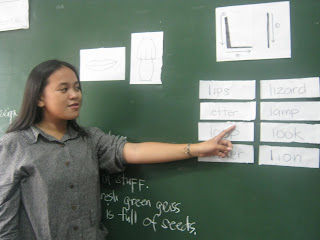TEACHING DEMONSTRATION
I have never tried to practice teaching. Well I was just imagining it in my head. So when the teaching demonstration was announced, I'm confused regarding how I feel. The process was draw lots where the students write their name on a paper and then Prof. Mely will get one for the continuity of presentation. I was absent when they did this so I have gotten no number. So when we were assigned to a specific date (September 19, 2011), there was no saying no. I haven’t got any idea on how to present it until that day.
LESSON PLAN
YEAR LEVEL: Kinder 1
I. Objectives
At the end of the lesson, at least 75 % of the class will be able to:
1. Identify the /l/ sound correctly
2. Produce the /l/ sound correctly
3. Write the letter 'L l' correctly
4. Differentiate the letter 'L l' from other letters
II. Subject Matter
The Letter 'L l'
III. Instructional Materials
Pictures, word strips, chalk, chalkboard
Objects – lantern, lighter, log, leaf
IV. Reference
Fun with Writing by Ocampo
V. Procedure
A. Prayer
B. Motivation
The class will sing the song.
Little Lady Lily is lying on the leaves.
The lady is little as a lily.
And they call her little lady Lily.
C. Lesson Proper
What consonant sound is being featured by the song?
Stick-out your tongue first. Place your tongue behind your teeth. And then, make a sound. The sound that is produced when you put your tongue behind your teeth is the /l/ sound. The /l/ sound is represented by the letter 'L l.' Let us read the word on the board.
lantern leaf lid
lizard lamp ladder
letter lips lion
log leech ladle
Now that we know the /l/ sound, let us practice how to write the letter 'L l.' We will write first the big letter L. Draw a straight vertical line. On the bottom part of the vertical line, draw a horizontal line. Let us practice the small letter l. Draw a straight vertical line.
A. Practice
a. Writing on the air.
Raise your writing hand on the air. Draw a straight vertical line. On the bottom part of the vertical line, draw a horizontal line. Let us practice the small letter l. Draw a straight vertical line.
b. Board writing
Come on the board and practice the letter 'L l'.
c. Draw a straight line to match the following words with its correct picture.
a. leaf
b. ladder
c. lizard
 d. lion
d. lion
e. lamp
E . Generalization
The sound 'L l' is produced when you put your tongue behind your teeth. It is represented by the letter 'L l.'
VI. Evaluation
a. Identify words containing the /l/ sound.
lamp ear bag
gum leaf dog
lantern cat lips
ladder man lion
b. Encircle the letters 'L' and 'l' in the series.
1. J J J J L J J J J J L
2. t t t t t I t t t I t t t t l
3. i i i I i I i i
4. L F F F F F F L
5. L I I I I L I I I L
VII. Assignment
A. Fill one page of your notebook writing the letter 'L l.'
B. Look around your house. Find 10 things that starts with letter 'L l.' Write them on your notebook.


















